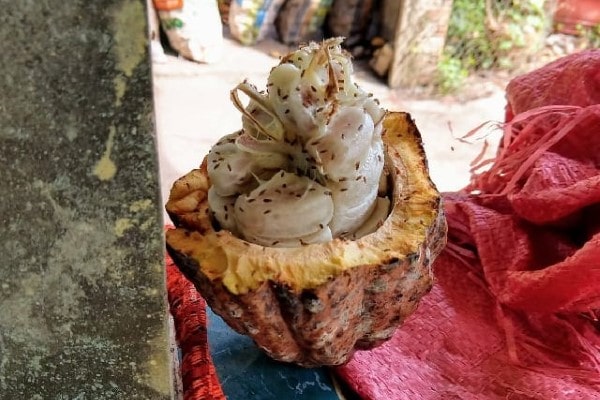¿Are you looking for the best Belize cocoa?
What Happens During Cacao Fermentation?

Fermentation is an essential part of turning raw cacao into delicious chocolate. This processing step contributes to the development of flavor and the acidity of the final product. But what actually happens during the process? Read on to learn more about the microbial activity, chemical reactions, and other elements involved in cacao fermentation.

Fresh cacao beans that have been bisected to reveal a violet inner seed, in Ecuador. Credit: Jeana Cadby
Fermentation in a Beanshell
Fermentation is essential to flavor development and the final acidity of cacao beans. In fact, it’s been stated that without fermentation, cacao would have no flavor at all. But one thing should be clarified: cacao beans are not fermented.
Rather, yeasts, bacteria, and enzymes ferment the juicy white pulp, or baba, that surrounds the cacao beans. The beans endure the heat, acid, and enzyme effects from the fermentation of the pulp and are transformed, both internally and externally, as a result.
The pulp itself is sterile before it’s removed from the pod, but naturally occurring yeast and bacteria soon find their way to the pulp when the pod is opened. These microbial inoculants come from a variety of sources in the local environment. This could be the outside of the pod, workers’ hands, visiting insects, or simply from the air. Sometimes the cacao is introduced to selected inoculants with a planned microbial cocktail.

An open cacao pod is visited by fruit flies in Vietnam. Credit: Jeana Cadby
Different Fermentation Methods
Fermentation methods vary depending on regional preferences and availability of resources. Individual producers will make different choices in the type and size of the fermentation vessel they use, the number of days they ferment cacao for, how often they turn the cacao, pulp preconditioning (pod storage prior to fermentation), and other factors.
But generally speaking, all cacao fermentation follows a similar process including an anaerobic phase and an aerobic phase. The specific details of each stage are influenced by a multitude of factors, not limited to pod ripeness, climactic and ambient weather conditions, pod quality, and batch size.

Fermenting cacao beans in the Philippines. Credit: Jeana Cadby
The Anaerobic Phase
Anaerobic conditions are simply environments that lack oxygen. In cacao, the pulp surrounding snugly packed beans creates a juicy barrier that blocks air from entering the system. The pulp is composed of water, high levels of sugars (sucrose, glucose, fructose), and various acids.
These sugars and the high acidity in the pulp create ideal conditions for microorganisms. The main players during this phase are yeasts, lactic-acid-producing bacteria, and pulp enzymes.
Using anaerobic respiration, yeasts quickly consume simple sugars and produce carbon dioxide, ethanol, and low amounts of energy. Lactic acid producing bacteria convert citric acid, glucose, and other carbohydrates in the pulp into lactic acid. Microbes are working around the clock to produce ethanol and lactic acid. You can see tiny bubbles of carbon dioxide gurgle up to the surface of the cacao in this stage.

In the early stages of fermentation, active yeast breaks down sugar found in the cacao pulp and produce bubbles of carbon dioxide. Credit: Jeana Cadby
Enzymes also help to break down the pulp, transforming it into a liquid that runs off and is known as sweatings. As the mass is broken down, there is more space for air to enter the process. Citric acid is also broken down and runs off with the sweatings, helping to increase the overall pH of the fermentation. The combination of rising pH and increased airflow marks the beginning of the aerobic phase of fermentation.

Workers in the Philippines turn fermentation boxes to introduce more air. Credit: Jeana Cadby
The Aerobic Phase
Aerobic conditions are environments that contain oxygen. In cacao processing, producers mix and move the beans, a process known as “turning”, to incorporate oxygen. The influence of this oxygen varies based on fermentation style, vessel, insulation, and the size of the ferment. But turning the beans will always make the fermentation process more uniform across the batch.
The aerobic stage is bursting with heat. During this step, acetic-acid-producing bacteria dominates and oxidizes ethanol and acids (citric, malic, lactic) to produce acetic acid. This acetic acid is further broken down into carbon dioxide and water by the oxygen.
Breaking down ethanol generates energy, which is expressed as heat. These exothermic reactions increase the overall temperature of the cacao. As the beans are turned, heat escapes and the overall temperature drops, but it then builds again through the introduction of more oxygen.
The combination of intense heat and the diffusion of ethanol and acetic acid into the cacao beans breaks down the cell walls. They will no longer germinate and the damaged internal structure becomes a venue for chemical activities that develop the flavor precursors associated with chocolate.

In Costa Rica, the outer pulp of fermenting beans has been shed and they are bisected to reveal oxidized juices. Credit: Jeana Cadby
Raw cacao beans have a bitter and astringent taste, due to their high phenolic content. Anthocyanins are one group of these polyphenols, and it both contributes to astringency and provide the reddish-purple color.
Fermentation allows the enzymatic breakdown of proteins and carbohydrates inside the bean, creating flavor development. This is aided by microbes, which create the perfect environment through the fermentation of the cacao pulp surrounding the beans.

In Vietnam, a producer checks baskets of fermenting cacao covered in banana leaves. Credit: Jeana Cadby
A fermented cacao bean won’t taste like cacao nibs – for that you need to dry and roast the beans. But fermentation is an essential process to create the chemical compounds we associate with that desirable chocolate flavor.
Written by Jeana Cadby.
This article first appeared on perfectdailygrind.com
